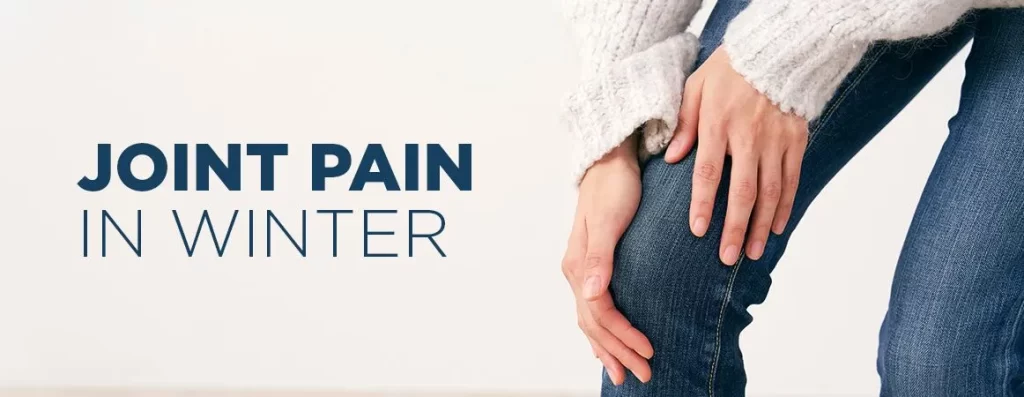Cold Joint Pain
As winter approaches, many people notice an increase in joint discomfort. For some, the cold weather brings stiffness and pain that can interfere with daily activities. Joints pain in winter is a common complaint, especially among individuals with arthritis, but it can affect anyone. Understanding the causes, symptoms, treatment options, and prevention tips can help you manage and reduce cold joint pain effectively.
Cold Joint Pain in Winter Causes
- Cold Temperature and Blood Flow: Cold weather can cause blood vessels to constrict, which reduces blood flow to the joints. This lack of blood flow may lead to stiffness, especially in the morning or after sitting for a prolonged period.
- Decreased Activity Levels: During winter, people tend to be less active, which can lead to muscle stiffness and reduced joint flexibility. A sedentary lifestyle in colder months can exacerbate joint pain.
- Barometric Pressure: When temperatures drop, barometric pressure often drops too. This change in pressure can cause joint tissues to expand, leading to more pain for individuals with arthritis or other joint conditions.
- Cold-Related Muscle Tension: Cold temperatures can cause muscles to tense up, which puts additional strain on the joints and can increase pain and stiffness.
Joint Pain in Winter Symptoms
The symptoms of joint pain in winter can vary from person to person. However, some common symptoms include:
- Stiffness: Cold weather often leads to increased stiffness, making it harder to move your joints freely.
- Aching and Discomfort: Joint pain in winter typically brings an aching or throbbing sensation, especially in the morning or after resting.
- Swelling: For people with arthritis, winter can trigger inflammation, which leads to swollen joints.
- Reduced Range of Motion: Increased stiffness and swelling can make it difficult to move the joint fully, limiting mobility.
These symptoms can impact various parts of the body, including knees, hips, shoulders, and fingers.
Joint Pain in Winter Treatment
Fortunately, there are several effective treatments to manage joint pain in winter. Here are some common approaches:
- Hot Therapy: Applying heat to affected areas can help increase blood flow, reduce stiffness, and soothe sore joints. Options include warm baths, hot water bottles, and heating pads.
- Exercise and Stretching: Regular, gentle exercise can improve joint flexibility and reduce stiffness. Activities like yoga, stretching, or low-impact aerobics are great for maintaining joint health during winter.
- Pain Relievers: Over-the-counter pain relievers can help alleviate pain and reduce inflammation. Be sure to consult a healthcare provider if you require regular use of these medications.
- Physical Therapy: A physical therapist can guide you through specific exercises to strengthen the muscles around the joints, which can help manage pain and prevent further discomfort.
- Moisturizing Creams and Ointments: Some creams are formulated to warm up muscles and joints, helping relieve pain.
Cold Join Pain Prevention Tips
Preventing joint pain in winter can be achieved by following some practical and effective tips:
- Stay Active: Try to stay physically active, even if it’s just light walking or stretching. Regular movement keeps joints flexible and reduces stiffness.
- Dress Warmly: Wearing warm layers and protecting your joints with gloves, scarves, and thermal wear can prevent stiffness caused by cold exposure.
- Use Supportive Footwear: During winter, wear comfortable, supportive shoes that offer proper cushioning for your knees and ankles, which can help reduce joint impact.
- Eat Anti-Inflammatory Foods: A diet rich in anti-inflammatory foods like leafy greens, nuts, and fatty fish can help reduce joint inflammation. Staying hydrated is equally important as it helps keep joints lubricated.
- Practice Good Posture: Whether working or relaxing, maintaining good posture reduces strain on the joints and helps minimize winter-related joint pain.
When to Consult a Doctor
While joint pain in winter can often be managed at home, some cases may require professional attention. If you experience severe pain, swelling, redness, or if the pain interferes with your daily activities. A doctor can offer a personalized treatment plan and may suggest additional therapies if needed.
Conclusion
Joint pain in winter can be uncomfortable, but understanding the causes and knowing how to treat and prevent it can make a significant difference. Recognizing common joint pain in winter symptoms, following effective treatment methods, and implementing prevention tips can help you enjoy the colder months with minimal discomfort. With regular exercise, warm clothing, and a healthy lifestyle, you can keep joint pain under control and maintain your mobility throughout the season.
Post Disclaimer
The information contained in this post is for general information purposes only. The information is provided by "Cold Joint Pain "and while we endeavour to keep the information up to date.
Legal Disclaimer
We do not claim to cure any disease which is considered’ incurable ‘ on the basis of scientific facts by modern medicine .The website’s content is not a substitute for direct, personal, professional medical care and diagnosis. None of the medicines mentioned in the posts ,including services mentioned at "medicineguide.us" should be used without clearance from your physician or health care provider.
Testimonials Disclaimer– : Results may vary, and testimonials are not claimed to represent typical results. The testimonials are real, and these patients have been treated with homeopathy treatment from our clinic . However, these results are meant as a showcase of what the best, Medicine can do with their disease contions and should not be taken as average or typical results.


